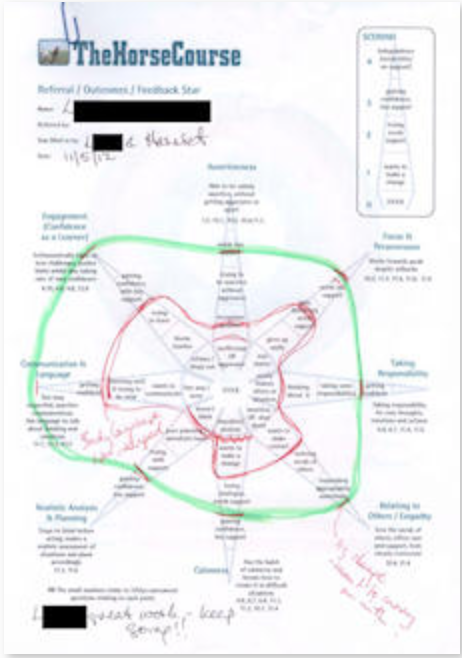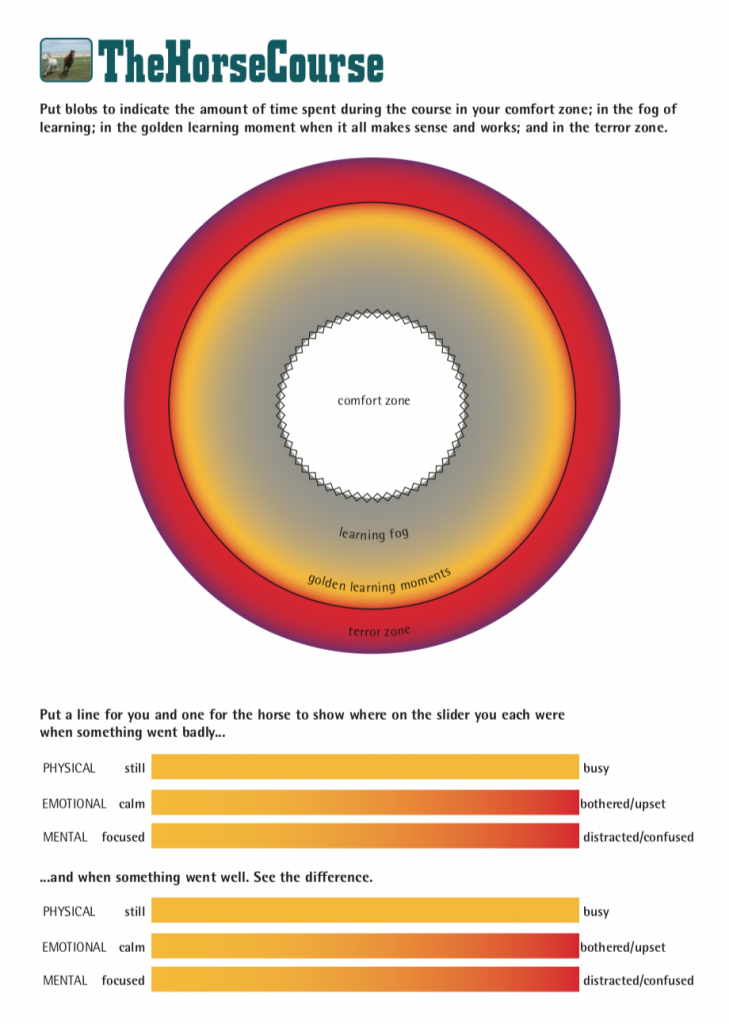METHOD
Summary of programme delivery
We teach, rehearse and repeat key resilience skills in an intensive and challenging, but fun way with feedback in-the-moment from specially trained horses. There is no discussion of the past. All sessions take place in action with the horses, there is no classroom content or talk-based therapy/counselling.
Tasks are guided by the facilitator and the horses are selected and trained to provide especially clear and easily observed physical feedback to participants, many of whom will not have interacted with horses prior to taking part in the programme. The methodological focus is on social/emotional shifts being made ‘in the moment’, in response to difficulties encountered. Participants are unmounted handlers, learning to work in partnership with the horses on the ground. The course employs an approach using a series of specific tasks as tools to develop positive habits. Specifically, the skills addressed by the course are:
Engagement (Confidence as a Learner) – enthusiastically taking on new challenges, pushing limits whilst also taking care of own confidence
Responsibility – taking responsibility for our own thoughts, emotions and actions
Calmness – having the habit of calmness and knowing how to create it in difficult situations
Assertiveness – able to be calmly assertive, without getting aggressive or upset
Realistic Analysis & Planning – Stopping to think before acting, making a realistic assessment of situations and planning accordingly
Focus & Perseverance – working towards goals despite setbacks
Relating to Others / Empathy – seeing the needs of others, offering care and support, feeling closely connected
Communication & Language – two way, respectful, assertive communications, having language to talk about thinking and emotions
On the last day, each participant has a robust reflective session with their facilitator – looking at their progress in each of the areas of the Skills Star (below). Upon successful completion of the course, participants are presented with a certificate.
A ten minute video is made for each participant and a brief report on their display of horsemanship. Participants receive a dvd of the video, and most are proud to share this with their family.
We have two courses, the ReStart and the Highlight and our facilitators also offer individual taster or top up sessions.The ReStart is usually delivered in 5 consecutive days, working for approx 2 hours per day with 1-to-1 facilitator support.
The ReStart is the course replicated from our successful work in prisons.
The Highlight is a one day adaptation of the ReStart, in which a group of participants will get a taste of the skills above but will only have time to work in detail on one or two key areas. For less extreme or less entrenched behaviour, we are finding a single day can be enough to trigger the crucial shift. This day has also been reported as a way to dramatically improve the relationships between staff and service users, resulting in lower levels of conflict and improved engagement or progress with talk-based provision.
For a ‘show and tell’ of how the course works, see this album of captioned photos: HMYOI Portland.
To read a narrative blog about the teaching method, see this article: Parelli Central Blog: “Parelli Horses helping UK Prisoners“.
Our methodology relies heavily on Parelli Natural Horsemanship, which we believe offers the greatest potential for practice in this field.
Dissemination
In order to make the maximum impact on social exclusion, we are keen to disseminate our course content, notes and materials to other practitioners for their own use. To this end we are working on a resources section here over time.
Please feel free to download any materials you find here. In return, we ask that anyone using our materials acknowledge us, do not misrepresent their degree of training or connection with us and do not present our materials as their own. Courses may not be described as “TheHorseCourse” without our prior written consent.
TheHorseCourse Star

The star shows the main areas we work on – at the centre of the star people are stuck in behaviours which are unhelpful. As they progress, they move outwards towards the points of the star. We assess progress by observation or in discussion with the participant – but always based on observations you have been able to make in session. By marking their level on each point you can join the marks and create ‘before’ and ‘after’ shapes. examples can be seen in our photo gallery.
Each ‘point’ has associated horsemanship exercises/strategies we use to work on the desired outcome.
The star is marked up as part of the referral process, later as the basis for discussion of outcomes together with the participant and finally as part of the feedback to referrers.

The most important use of the star is as a way of discussing and reflecting on the course in the exit interview. We talk through each point, thinking about where the participant was at the beginning of the course and how far they got by the end. We reflect on specific moments that would ‘evidence’ these marks in session 1 and sessions 6 or 7. The marks are made by the instructor, following robust and realistic discussion. All the ‘before’ marks join up to make a shape as do the ‘after’ marks. The ‘after’ shape is always bigger, but each participant makes progress at a different rate. The one shown here is fairly typical.
There is then a handover – the participant keeps a copy of their star and takes responsibility for managing their own progress towards the edges. They learn that these skills are like muscles, if you don’t work at them they disappear. We discuss how each skill has an impact on the way life works.

Generally participants are very proud and surprised by how much they have learnt, about themselves and about the skills of self management. They seem empowered by the star. We only started using it in 2012 – we are really pleased with it so far.
UK Prison oriented people may be interested in the correlation between the star points and the identified needs in OASys (Offender Assessment System). This version of the star shows the roughly corresponding sections. View PDF.
TheHorseCourse Observation Chart: inspired by the Parelli Horsenality model; used by Dr Hemingway in a field study and now used as our primary case note tool.
Comfort Zone

The comfort zone chart asks participants to map and reflect on their time during the course spent feeling comfortable (white), feeling confused (in the grey fog of learning) and the (golden) moments of learning. We also check whether there were any (red) terror moments. Participants can then reflect with us on the learning process.
The slider bars are to compare the participant’s mental and emotional state within a task firstly when it was not working and then when it did work. They usually realise, when they see it in this visual format, that being calm and focused makes all the difference!
NB. Parelli Natural Horsemanship (PNH) is at the forefront of the global “Natural Horsemanship” movement and represents an approach developed in the US over the past 30 years. PNH is a comprehensive system of horse training which aims to achieve a harmonious partnership, and is formally assessed at four levels, gradually developing the horse/human relationship from Level 1 which covers safety and basic competence to Level 4 in which horse and human work in complete harmony in movements on the ground (including liberty) as well as ridden (including free-horse riding).